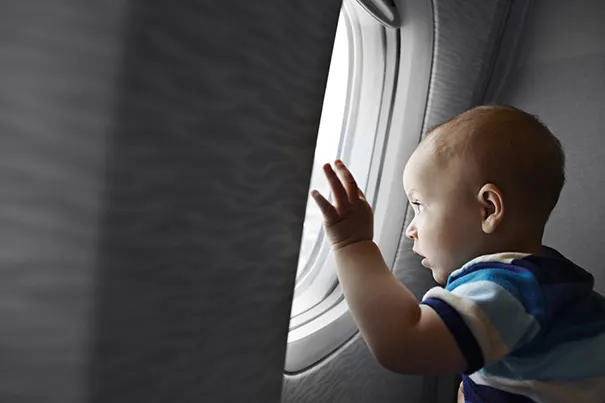Flying with an infant

For many young children and infants, there is no more exciting way to travel than by air. They love to watch the carts, trucks and aeroplanes at the airport. Even better, they may get to ride on moving walkways, trains and trams, escalators and lifts – all that even before boarding. On the plane itself, there are the endlessly fascinating tray tables, window shades, and teeny tiny bathrooms to explore, again and again.
Parents, of course, may long wistfully for the days when air travel was more pleasant and glamorous, or at least less crowded. But a child's enthusiasm is often hard to resist.
Encourage your child's spirit of adventure and your own by pointing out the shops, fountains, artwork and sculpture as you make your way to your departure gate. Notice the other families travelling together, and talk with your child about where they are coming from and where they might be going – a great way to pass the time while waiting.
Here are a few tips to make air travel more fun and less stressful
Try to have everyone get a good night's sleep before your travel day and stick to routines as much as possible.
You may save some time (or at least time spent standing in queues) if you check in online before you leave home or at a self-service kiosk at the airport.
Confirm flight status before you leave home. If your flight is delayed or cancelled, everyone will be happier waiting in comfortable surroundings.
A child-carrier is good for carrying infants or toddlers through airports and allows you to keep your hands free. It does need to be removed before going through airport security, however.
Have each child carry a small rucksack with a few small toys or books, a non-perishable snack, and a change of clothing in case of accidents.
Gate attendants usually offer families with small children the opportunity to enter the plane first. Take advantage of that so you don't have to fight through the crowds to get to your seats and get everyone settled. Exit last for the same reason unless you have tight connections.
You can order special children's meals ahead of time through the airline or travel agent.
Make sure that you have enough time between flights if possible. Layovers between flights can be beneficial, as they give the children a chance to walk/run around a bit and expend some energy. If you do have close connections, ask the flight attendant for assistance; if you ask in advance, there should be a cart waiting to take you to the next gate.
Check in the pushchair at the gate so you can use it to get through the airport rather than carrying a child.
If you can afford it, purchase a seat for each child, especially for long flights. For information on using a child safety seat or other approved child restraint system, visit the FAA website's section on Child Safety on Aeroplanes.
During the flight, for a little break, take a walk up and down the aisle when the 'fasten seat belt' sign is off.
Don't hesitate to ask the flight attendant or the person sitting next to you for help, especially if you are travelling as a single adult. Many other people have been or will be in similar situations and don't mind lending a hand.
And finally, try not to take out your own fears or frustrations on your children. If your child melts down mid-flight, don't worry about what other people on the plane are thinking.
Focus on your children and trying to make them as comfortable as possible. Travelling is a great adventure, so have fun!

